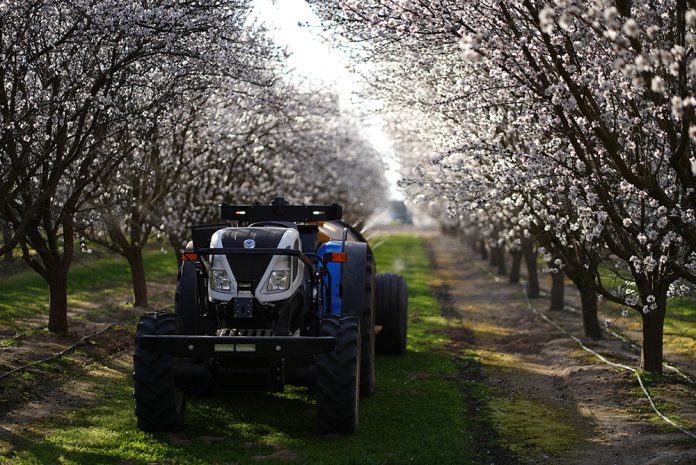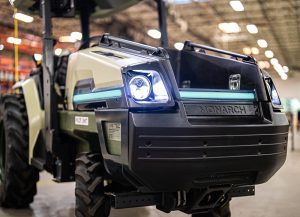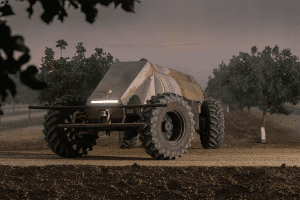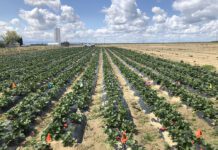
We have entered a new era in the evolution of farm equipment. 185-year-old farm machinery giant John Deere kicked off 2022 with the announcement that their new fully autonomous 8R tractor was ready for large-scale production. This followed their acquisition of Bear Flag Robotics a few months prior, whose technology retrofits traditional tractors to make them autonomous.
The John Deere 8R is likely more of a fit for Midwest row crop agriculture, but it symbolizes a shift in American agriculture toward autonomy. In almond orchards, there are already autonomous options for tasks like making applications, mowing, and discing, with several other potential use cases on the horizon. Labor savings, efficiency gains and cost reductions are a few reasons to explore these technologies and the options are more accessible than you might think.
More Efficiency, More Savings
Almond production is highly mechanized, efficient and not as labor-intensive as some of the other specialty crops. But with labor costs and regulations continuing to rise, attracting, affording and retaining qualified employees is a real challenge.
When Kingsburg-based Crinklaw Farm Services had trouble filling the seats of 130 spray rigs in their custom spraying fleet, owner Dave Crinklaw was determined to find a solution. Three years later, their first fully autonomous sprayer was ready for operation and GUSS Automation was born.
“We were sending guys two to four hours away from home,” said GUSS COO Gary Thompson. “They spray all night long at two miles an hour. It’s just a challenging position to hire for and get people who want to do this work.”
Now, one employee can operate up to eight autonomous sprayers at once using a laptop, tending to the sprayer only if there is a problem and when it needs to be refilled. Not only does this allow for fewer employees per sprayer, but it’s also a more enjoyable job for the operator and allows for a more efficient process.
“Two miles an hour is what most pest control advisers are going to suggest for spraying,” Thompson said. “Trying to get your drivers to do two miles an hour all night long when they’re spraying is very challenging. But autonomous sprayers don’t mind. You’re getting a much more precise spray.”
This level of automated consistency allows growers to maximize investments in fuel, labor and chemical inputs. Thompson also points to refilling time, which tends to go much quicker with an autonomous sprayer that doesn’t need a break.
“The nurse truck driver pulls up, he jumps out, there’s nobody to talk to. He hooks up the hose, fills it, and three minutes later it’s spraying again,” he said.
The gains from autonomy are not just about reducing employee headcount. These technologies can improve the nature of the work for employees. Rather than sitting on a piece of equipment for hours trying to keep it right at two miles per hour, farm employees can focus on higher-value tasks.
Driver Optional
There are a lot of reasons why growers would still want the option to drive the tractor rather than operating it autonomously. Monarch Tractor, for example, sells a compact, driver-optional tractor that is compatible with existing farm implements. They offer another big potential cost savings to growers as well: The unit is 100% electric with a swappable battery.
“Save money on diesel, reduce your emissions to meet sustainability metrics that buyers are asking for, and cut labor costs by having drivers manage fleets instead of just one tractor,” said Monarch Tractor CEO Praveen Penmetsa.
Penmetsa believes they are reimagining what a tractor can be. Large global farm equipment manufacturer CNH Industrial has bought into this vision by becoming an investor in Monarch.
But many believe that the move to autonomous equipment shouldn’t involve replacing an entire fleet. Companies such as Blue White Robotics, Kingman Ag, FieldIn and others are offering retrofit kits that give existing farm machinery autonomous capabilities.
Blue White Robotics founder Ben Alfi believes that adaptability and accessibility are very important for growers that are utilizing autonomous capabilities for the first time. “We’ll take any tractor that the grower has, no matter what type of color or size or design, and we’ll retrofit it, connect it and provide on-the-job training and support,” he said.
These retrofit options allow the driver to switch back and forth from manual to autonomous depending on the task. They also provide a lower barrier to entry for growers interested in seeing if autonomy can provide sufficient return on investment for their operation.
In some cases, it may make the most sense for autonomous technology to be offered as a service. This is especially true if growers won’t need the equipment repeatedly throughout the year. As examples, Sabanto retrofits tractors with their technology and offers autonomous “farming as a service”, and Rantizo is one example of spot-spraying as a service using swarms of autonomous drones. In specialty crops, companies like Farmwise offer robotic weeders as a service to vegetable growers.
InsightTRAC is attempting a similar “robots as a service” model in almonds with their fully autonomous mummy removal rover. The unit is designed to roam through the orchards, spot mummies using computer vision and remove them with a biodegradable pellet. The rovers are still being tested in California and Australia, but the company hopes to have a commercial service offering on a limited basis in 2023.
Future Challenges
There are still some technical barriers that need to be overcome to reach widespread adoption of autonomous technology, but economics and regulation also constitute significant factors. “A major challenge for autonomy is the cost. You have to make sure your autonomous system is cost-effective,” said Dr. Stavros Vougioukas, professor of biological and agricultural engineering at UC Davis.
Vougioukas said that in many on-farm use cases (e.g., fruit harvesting), the majority of efficiencies and labor savings comes from mechanization and automation without necessarily replacing the equipment operator. “Whether you are replacing the driver or not doesn’t always have a huge impact on the overall economics,” he said.
One additional charge to be aware of are software-as-a-service (SaaS) fees. These are generally not substantial, but it’s a recurring charge to keep the software updated and current.
A second significant challenge has to do with safety. Monarch Tractor recently had a petition denied by the California Division of Occupational Safety and Health that sought to clarify the use of driver-optional tractors without a human operator stationed on the vehicle. Despite this setback, Monarch continues to work with Cal/OSHA and sell their technology in hopes of regulatory clarity in the future.
A recent challenge that the almond industry is all too familiar with are supply chain constraints. Some important components for these technologies have at times been difficult to obtain. Most in the industry seem to agree that this is a temporary problem that will get resolved over time, but it is certainly something to be aware of before investing in this technology.
These challenges are real but seemingly surmountable as the cost of technology trends lower, regulations get clarified and supply chains free up.
The Data Flywheel
Autonomous equipment has evolved as a result of the digitization of farming over the past couple of decades. Farm data has trained algorithms and artificial intelligence models to run the machines. Now with more autonomous machines finding their way into orchards, even more data will be generated through the computer vision used for guidance systems and the various sensors these vehicles are equipped with. These massive data sets will be used to create even more useful models and tools for growers in the future.
Dr. Mason Earles at the Plant AI and Biophysics Lab at UC Davis is preparing for this future by building models that can estimate yield based on video data. Earles’ work focuses on full automation solutions from sensing and data pipelines to data analysis and grower insights.
Through a grant from the Almond Board of California, Earles and his team are developing an ag sensing solution called AgKit. This project includes an autonomous sensing device that is mounted on the front of a tractor that captures video footage as people are driving through the orchard. Researchers are then using this data to develop agricultural and biological models for important functions like yield prediction, tree health and pest and disease scouting.
“The AgKit is low-cost, quick to install and retrofits on any tractor,” said Earles. “We want to start getting data and building these models now so that in three to five years, when all of this video footage is being generated from autonomous tractors, we have already done the work that can be used for generating the agronomic insights.”
Earles has been working on AgKit in grapes for even longer than almonds with a specific focus on yield prediction and forecasting. He is hoping to make similar progress in almonds alongside Vougioukas, who is developing techniques for real-time automated yield monitoring.

“In-field yield data is an important part of all of this. Without granular, ground-truthed yield data, we can’t know for sure how accurate our yield prediction models are.”
This is another major step in the evolution of efficient orchard management: More accurate, real-time yield prediction and monitoring. This is possible with the flywheel between data and automation combined with the investment in research to develop these models.
The Journey Toward Autonomy
Even with these advancements, the path toward farm autonomy is not a short one. Iftach Birger grew up on a large almond farm in Israel but chose to launch digital ag startup FieldIn rather than returning to the orchard. Birger said a lot of people in his generation are making a similar choice.
“The way that the next generation will evolve farming will be when they are ready to embrace 21st-century tools,” said Birger. “21st-century farms utilize data and automation to run the farm in a different way.”
FieldIn’s auto-spray is the first of a series of autonomous products the company is launching to help growers along their journey to an autonomous farm. Birger and colleagues have outlined a five-step journey toward farm autonomy which includes digitizing the farm, benchmarking key metrics, identifying and deploying the right autonomous technology, automating decision making and re-designing the farm around these capabilities.

“We have a basic set of rules for autonomy,” said Birger. “It needs to provide return on investment from day one. It needs to be very straightforward to use. It needs to be a risk mitigator. And it needs to do something that a human cannot easily and repeatedly do.”
References
“John Deere Reveals Fully Autonomous Tractor at CES 2022” https://www.deere.com/en/news/all-news/autonomous-tractor-reveal/
“John Deere Acquires Bear Flag Robotics to Accelerate Autonomous Technology on the Farm” https://www.deere.com/en/news/all-news/2021aug5-bear-flag-robotics/
“CNH Industrial, Monarch Tractor agree electrification technologies deal” https://www.reuters.com/technology/cnh-industrial-monarch-tractor-agree-electrification-technologies-deal-2021-11-03/
“Cleaning Robots: Out of Your Home and Into Your Orchard” https://www.e-digitaleditions.com/i/1413164-2021-sept-oct-how-we-grow/5?
“Monarch Tractor’s Petition for Updated Autonomous Tractor Regulations Denied” https://www.precisionfarmingdealer.com/articles/5132-monarch-tractors-petition-for-updated-autonomous-tractor-regulations-denied
Companies and images used in this article do not reflect endorsement by the Almond Board of California.















